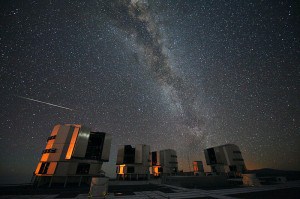
 The Perseid meteor shower, an annual celestial event beloved by millions of skywatchers around the world, returns to the night sky this week, peaking late-night on Aug. 11-12 and continuing for several days through mid-August. And because the Moon will be in its crescent phase and setting in early evening, no moonlight will hinder the viewing in the later evening hours.
The Perseid meteor shower, an annual celestial event beloved by millions of skywatchers around the world, returns to the night sky this week, peaking late-night on Aug. 11-12 and continuing for several days through mid-August. And because the Moon will be in its crescent phase and setting in early evening, no moonlight will hinder the viewing in the later evening hours.
Although an occasional Perseid meteor might catch your attention shortly after evening twilight ends, the prime viewing hours are from about 11 p.m. or midnight (local time) until the first light of dawn. This is when the shower’s “radiant” (its perspective point of origin) is high up in your sky. The higher the radiant, the more meteors appear all over the sky.
To enjoy the Perseids, you need no equipment but your eyes. Find a dark spot with a wide-open view overhead. Bring a reclining lawn chair or a ground cloth so you can lie back and watch the sky in comfort. Patience will be needed—in a dark sky, with little or no light pollution, you could see an average of about one meteor per minute.
Perseids can appear anywhere and everywhere in the sky. Faint Perseids appear as tiny, quick streaks. Occasional brighter ones might sail across the heavens for several seconds and leave a brief train of glowing smoke.
When you see a meteor, track its path backward. If you eventually come to the constellation Perseus—which climbs the northeastern sky as the night progresses—then a Perseid is what you’ve just witnessed.
Occasionally you might spot an interloper. The weaker Delta Aquarid and Kappa Cygnid showers are also active during Perseid season, and there are always a few random, “sporadic” meteors. All of these track back to other parts of the sky.
Any light pollution will cut down the numbers visible. So will the radiant’s lower altitude if you’re viewing early in the night. But the brightest few meteors shine right through light pollution, and the few that happen when the radiant is low are especially long—skimming the upper atmosphere and flying far across the heavens.
Meteors are caused by tiny, sand- to pea-size bits of dusty debris streaking into the top of Earth’s atmosphere about 80 miles up. Each Perseid particle zips in at 37 miles per second, creating a quick, white-hot streak of superheated air. The nuggets in Grape Nuts cereal are a close match to the estimated size, color, and texture of typical meteor-shower particles.
These particular bits were shed long ago by Comet Swift-Tuttle and are distributed all along the comet’s orbit around the Sun. Earth passes through this tenuous “river of rubble” every year in mid-August.
More about the Perseids and how to watch them appears in the August issue of Sky & Telescope magazine and at: http://SkyandTelescope.com/Perseids
INTERNATIONAL STARRY NIGHT EVENTS
Coinciding with the Perseid meteor shower, events are being held around the world to celebrate the first “International Starry Night, a Celebration of Starlight.” Check them out at: www.starry-night.org
for more, go to stardate.org/mediacenter/2013-perseids


Be the first to comment